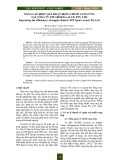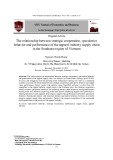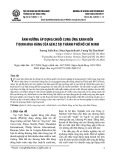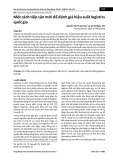
Effect of information sharing in
supply chains: understanding the
roles of supply chain visibility,
agility, collaboration on supply
chain performance
Charles Baah
Transportation Engineering College, Dalian Maritime University, Dalian, China
Douglas Opoku Agyeman
Department of Marketing and Entrepreneurship, University of Ghana, Accra, Ghana
Innocent Senyo Kwasi Acquah
Department of Marketing and Supply Chain Management, University of Cape Coast,
Cape Coast, Ghana
Yaw Agyabeng-Mensah and Ebenezer Afum
Transportation Engineering College, Dalian Maritime University, Dalian, China
Kassimu Issau and Daniel Ofori
Department of Marketing and Supply Chain Management, University of Cape Coast,
Cape Coast, Ghana, and
Daniel Faibil
Faculty of Management and Economics, Dalian University of Technology,
Dalian, China
Abstract
Purpose –Exploring ways to acquire, sustain and improve competitive positions in supply chains through
information sharing, supply chain visibility, collaboration and agility have been essential for scholars and
practitioners. Basing on the relational view, resource based view and the extended resource based view, this
study assesses the critical role of information sharing in supply chains through emphasizing its effect on
supply chain visibility, collaboration, agility and supply chain performance. Particularly, the study proposes
that information sharing, supply chain visibility, collaboration and agility collectively have crucial direct and
indirect influences on supply chain performance which lead to superior gains, competitiveness and flexibility.
Design/methodology/approach –The study adopted a survey research design, a quantitative approach
and partial least square structural equation modeling (PLS-SEM) in making data analysis and
interpretations due to its suitability for predictive research models.
Findings –The results indicate information sharing positively and significantly influenced supply chain
visibility, collaboration, agility and performance. Supply chain visibility presented significant effects on
collaboration, agility and performance, while supply chain collaboration and agility had significant impact
on supply chain performance. The study findings connote that information sharing is key to enhancing
competitive gains and superior supply chain performance.
Originality/value –The study is among the few to probe on how information sharing as a variable
interacts with supply chain visibility, collaboration, agility and performance. Although, information
sharing has received a lot of attention in supply chains, this study is among the first to capture the study
variables in a single model and thus, exposes the vital need for information sharing in improving supply
chain performance seeing that it ensured significant and robust impacts on the study variables.
Keywords Information sharing, Supply chain visibility, Supply chain collaboration, Supply chain agility,
Supply chain performance, PLS-SEM
Paper type Research paper
Effect of
information
sharing in
supply chains
The current issue and full text archive of this journal is available on Emerald Insight at:
https://www.emerald.com/insight/1463-5771.htm
Received 26 August 2020
Revised 16 November 2020
30 November 2020
Accepted 11 December 2020
Benchmarking: An International
Journal
© Emerald Publishing Limited
1463-5771
DOI 10.1108/BIJ-08-2020-0453

1. Introduction
In recent times, competition on the basis of supply chains has attracted significant attention
especially in relation to facing uncertainties in business environments. Accordingly, scientific
contributions on supply chains have projected the critical role of information sharing which
forms the basis of supply chain visibility, collaborations and agility (Cao and Zhang, 2011;
Abdallah et al., 2017;Mor et al., 2018;Routroy et al., 2018). Thus, in a firm’s quest to survive
and achieve competitive advantages, there is the vital need to create and share or disseminate
information that is relevant, timely and up-to-date. A firm’s ability to ensure the acquisition
and sharing of such information across its supply chain according to several scholars will
experience enhanced supply chain collaborations, visibility, agility, competitive/
collaborative advantage and supply chain performance (Nyaga et al., 2010;Mishra et al.,
2018;Routroy et al., 2018). Despite the attention given to information sharing as a critical
antecedent to supply chain visibility (Mor et al., 2018), collaboration (Cao and Zhang, 2011),
agility (Brusset, 2016) and performance (Sezen, 2008;Prakash et al., 2017), few studies have
observed the interactions between these variables in a single model thus creating the need for
further probe to establish the robust influence of information sharing as well as observe the
direct and indirect effects among these variables.
Consistent with the indicated premise, information sharing according to Colicchia et al.
(2018) is the glue that holds supply chains together especially with regards to supply chain
partners. Singh et al. (2020) further indicated that miscommunications, which result from poor
information sharing, creates conflicts and misunderstandings in supply chains, which defeat
the overall goal of superior performance. Cao and Zhang (2011) recommended that information
sharing is a critical component of supply chain collaborations and as such, collaborations
between supply chain partners can be based on leveraging information sharing to acquire
competitive advantage. A significant amount of research has focused on supply chain visibility
and how it enhances supply chain practices leading to superior competitive positions (Barrat
and Oke, 2007;Williams et al., 2013;Caridi et al.,2014;Singh et al.,2019). Although in these past
researches, information sharing was dominant in the explanation of key visibility, collaboration
and agility concepts, this is among the few studies that captures information sharing as a
variable seeking to establish effects on supply chain visibility, collaboration, agility and
performance. According to Prakash et al. (2017), firms are now focusing on supply chains and
therefore are adopting ways that improve supply chain connections since a supply chain stays
connected by sharing of information, finance and materials by suppliers, producers, retailers,
distributors and customers. The author further highlighted that the important value of sharing
information within a supply chain relates to how the benefits outweighs the costs involved.
Furthermore, in the scrutiny of supply chain visibility, collaboration and agility, the
existing literature has ignored the indirecteffectsthesevariableshaveinensuring
enhanced supply chain performance. Supply chain visibility according to Kumar and Singh
(2017) had initial definitions centered on the ability to access and share information across
supply chains and using this information in real time. Barrat and Oke (2007) further
indicated that supply chain visibility relies on sharing not just any information but
information that is deemed accurate, trusted, timely, useful and useable in supply chains.
This definition as captured by Barrat and Oke (2007) suggests that supply chain visibility
also plays important role in enhancing supply chain collaborations, agility and
performance. This is because supply chain visibility will build the trust of supply chain
partners leading to improved collaborations and agility, which ends up improving supply
chain performance. Supply chain collaborations as reflected by Cao and Zhang (2011) is a
very important component in achieving collaborative advantage. The authors further
reflect the relevance of collaborations among supply chain partners by connoting that
collaborative initiatives among supply chain partners promote cost reduction, risk sharing,
complementary assets, rapid learning, among others. The authors also agreed with
BIJ

Feizabadi et al. (2019) and Kumar Singh and Modgil (2020) in asserting that supply chain
collaborations enables a firm to build speed, which helps to quickly take advantage of
market opportunities, introduce new products, solve problems, among others hence
reducing market risks associated with market volatility, thus, building on the concept of
supply chain agility.
Supply chain agility according to Gligor et al. (2013) have received great attention over the past
decade. However, there exists no universally accepted definition for the concept. Gligor et al.(2013)
thus proceeded to give their definition as “afirm’s ability to quickly adjust tactics and operations
within its supply chain to respond or adapt to changes, opportunities, or threats in its
environment.”Brusset (2016) also indicated the fundamentals of supply chain agility as being
able to swiftly respond to market changes in addition to exploiting opportunities whiles dealing
with threats through market sensitivity, information sharing, network-based flexibility and
process integration. Currently, supply chain managers are under pressure to instill agility in
supply chains to match the speed of change and the accelerating competition in markets
(Choudhary and Sangwan, 2018). This shows how relevant supply chain agility is when it comes
to ensuring sustained supply chain performance. Nonetheless, ensuring sustained or improved
supply chain performance is very vital in current business environments where competition has
shifted from firms to supply chains (Sezen, 2008;Abdallah et al., 2017). From the above brief
explanation of the supply chain visibility, collaboration and agility concepts, it is evident that for
these concepts to be operationalized effectively to improve supply chain performance,
information sharing is very vital. Thus, this study focuses on the effects of information
sharing in interacting with supply chain visibility, collaboration, agility and performance.
The study further highlights on the direct and indirect effects of information sharing, supply
chain visibility, collaboration and agility in influencing supply chain performance.
Moreover, the study after establishing directs effects among variables will also seek to
establish indirect effects among variables to enhance knowledge and practice. Again, the
study was centered on manufacturing firms due to how such firms and industries are
dependent on supply chains to enhance superior overall firm performance. The small and
medium-sized enterprises’(SMEs) nature of most firms operational in the Ghanaian
manufacturing sector also influences the nature of the study in that most of these firms have
supply chains that lack key resources such as information technology investments among
others. However, it is worth mentioning that the absence of these resources does not critically
impact supply chains due to their supply chains being less complex as compared to
non-SMEs. This indicate that due to the less complex nature of SMEs supply chains, more
attention can be given to supply chain partners in addition to other collaborative investments
to boost supply chain performance.
From the above discussions, the study develops and seeks to respond to the following
research questions; (a) how do information sharing, supply chain visibility, supply chain
collaboration, supply chain agility and supply chain performance interact in a single model,
(b) how does information sharing directly influences supply chain visibility, supply chain
collaboration, supply chain agility and supply chain performance and (c) how do supply
chain visibility, supply chain collaboration, supply chain agility indirectly influence supply
chain performance. The next section describes the review of literature and hypothesis
development before exposing the research methodology in Section 3.Section 4 reports
analysis of data and discussions while Section 5 captures conclusions, implications for theory
and practice and limitations and suggestions for future research.
2. Literature review
2.1 Theoretical paradigms
Over the years, the need to strategically position supply chains to be able to gain better
outcomes have been key for managers and academics (Dubey et al., 2018;Baah and Jin, 2019;
Effect of
information
sharing in
supply chains

Baah et al., 2020a, b, 2021b). This contributes to the reasons why current competition arenas’
captures supply chains other than individual firms. The relational view which was proposed
by Dyer and Singh (1998) posits that critical resources span across firm borders and as such,
supply chain collaborations should be enhanced to enjoy supernormal profits. Dubey et al.
(2020) further explained that supernormal profits come in the form of rents that cannot be
generated by individual firms. Thus, the authors recommended the need for firms to create
collaborative alliances so as to create not only internal rents but also relational rents. Dubey
et al. (2020) in agreement with Feizabadi et al. (2019) suggested that relational rents are
possible when collaborating partners combine and exchanges knowledge, assets and
capabilities through joint investments, inter-firm knowledge sharing initiatives,
complementing resources, effective governance mechanisms, among others. Thus, the
relational view posits that collaborations in supply chains enable joint value creation, which
would have been impossible on individual firm basis and also projects gains for mutual
benefits.
This relational view was further supplemented by the resource based view by giving a
detailed perspective on collaborative efforts in supply chains and how they accrue diverse
and important benefits for partners (Cao and Zhang, 2011;Barney, 2012;Yang et al., 2019).
The resource based view connotes that differences in firm outputs can be explained by
differences in strategic resources, capabilities and assets. Most importantly, core competence,
dynamic capabilities and absorptive capacity of firms precede all from the resource based
view perspective in that firms that are able to master these in addition to unique combination
of resources will achieve greater advantages than competing firms (Cao and Zhang, 2011;
Collins, 2021). Barney (2012) further highlighted that firms that excel in core competencies
and capabilities in addition to owning strategic resources will likely see greater outputs.
Practically, the resource based view explains that companies that form collaborations and
other forms of alliances that go to the core of joint assets investments can lead to building
competitive advantages due to the rare, valuable, non-imitable and non-substitutable nature
(Barney, 2012). Past studies basing on the resource based view explain dynamic capabilities
as the capacity of managers and other workers to affect and adjust resource allocations
thereby bringing in play new organizational thoughts (Aslam et al., 2018;Dubey et al., 2020).
The absorptive capacity as mentioned by Dyer and Singh (1998) and Cao and Zhang (2011)
revolves around a firm’s ability to assimilate and use vital information or knowledge to
improve specific firm skills in achieving economies of scale mostly through the learning
effect. Thus, the resource based view being complementary to the relational view projects
supply chain visibility, agility and collaborations to improving supply chain performance.
Furthermore, the study highlights the extended resource based view which posits that
firms enjoy or achieves advantages on the basis of ability to access resources and use
resources or enjoy resource associated benefits (Cao and Zhang, 2011;Collins, 2021). Again
inter-connected firms as espoused by Collins (2021) form dyadic collaborations or alliances
that integrate both external and internal resources to achieve competitive advantages.
According to Collins (2021), these competitive advantages that accrue to firms in dyadic
collaborations or alliances can be categorized into four key elements namely; internal rents
which is benefits derived from the focal firms shared and non-shared resources, appropriated
relational rent which captures benefits only derived from shared resources of partners,
inbound spillover rent which is benefits extracted from partners shared and non-shared
resources by reason of knowledge leakages and inter-firm learning and outbound spillover
rent which is benefits derived from the transfer of benefits from focal firm to partners. These
benefit categorizations exist for mutual benefits of supply chain partners and as such, lead to
better performance of supply chains and its components since an effective and efficient
supply chain collaborations rely on information sharing, visibility in supply chains leading to
supply chain agility and performance.
BIJ

Based on the relational view, resource based view and the extended resource based view,
this study highlights that information sharing is critical for improved and sustained supply
chain performance, collaborative advantage and competitiveness (Holcomb et al., 2011;
Cao and Zhang, 2011;Feizabadi et al., 2019;Collins, 2021). Despite the critical role of
information sharing, few studies have aimed to elaborate on how it boosts supply chain
visibility, supply chain collaboration, supply chain agility and supply chain performance in
the context of an emerging economy and from the perspectives of SMEs. This study
specifically seeks to contribute to the literature by exposing how information sharing directly
affects SMEs supply chain visibility, supply chain collaboration, supply chain agility and
supply chain performance. In addition, the study further exposes the indirect roles of supply
chain visibility, supply chain collaboration and supply chain agility on supply chain
performance (Prakash et al., 2017;Baah et al., 2021a;Singh et al., 2021a). This study is relevant
in that it contributes to knowledge on information sharing, supply chain visibility, supply
chain collaboration, supply chain agility, supply chain performance and how these variables
interact directly and indirectly.
2.2 Conceptual development
Supply chain performance would likely stand higher chances of sustained or superior
performance though the sharing of vital, timely, useful and up-to-date information which
leads to improved supply chain visibility, collaborations and agility (Cao and Zhang, 2011;
Caridi et al., 2014;Brusset, 2016). Barrat (2004) also indicated that by collaborative efforts in
supply chains, partners are motivated to work together as a single unit thus, allowing access
to each other’s resources leading to mutual benefits and advantages. These collaborations in
supply chains definitely have a bearing (improved effect) on supply chain performance as
well as the other variables captured in the study namely; information sharing, supply chain
visibility, collaboration and agility. These direct and indirect interactions among adopted
study variables are captured in Figure 1 briefly explained below are the study variables.
Information sharing has received great attention especially in supply chains due to how
critical it is to crafting strategic supply chain responses (Colicchia et al., 2018;Yang et al.,
2019). According to Colicchia et al. (2018), firms are investing seriously in information
technologies due to the need for adaptability in respond quickly to market changes. For firms
to be fast in responding to market changes, firms must have knowledge of new and useful
information generated in the environment and adopt strategies in making fast decisions
based on this new information (Colicchia et al., 2018;Yang et al., 2019). More critically,
Figure 1.
Conceptual model
showing hypotheses
Effect of
information
sharing in
supply chains

![Sổ tay Hướng dẫn phát triển chuỗi cung ứng [Chuẩn nhất]](https://cdn.tailieu.vn/images/document/thumbnail/2025/20251007/kimphuong1001/135x160/26201759828896.jpg)

![Tổng quan môn học Quản trị logistics kinh doanh: [Thông tin chi tiết/Hướng dẫn/Tài liệu]](https://cdn.tailieu.vn/images/document/thumbnail/2025/20250604/nganga_00/135x160/624_tong-quan-mon-hoc-quan-tri-logistics-kinh-doanh.jpg)













![Đề kiểm tra Quản trị logistics [mới nhất]](https://cdn.tailieu.vn/images/document/thumbnail/2025/20251015/2221002303@sv.ufm.edu.vn/135x160/35151760580355.jpg)
![Bộ câu hỏi thi vấn đáp Quản trị Logistics [năm hiện tại]](https://cdn.tailieu.vn/images/document/thumbnail/2025/20251014/baopn2005@gmail.com/135x160/40361760495274.jpg)







